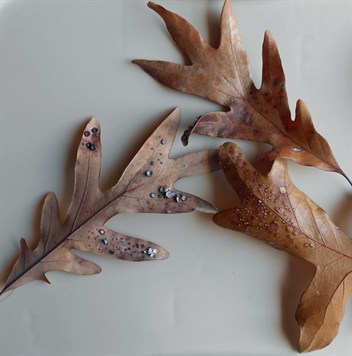It is an eye-catcher: A driveway dotted with thousands of tiny
discs, as if bumblebees golf students just graduated and tossed
their woolen tam-o-shanter hats. The gardener looks up for the
source, and then back down at the oak leaves that have fallen.
We see marks on the leaves and it's clear the pom-poms were once
attached there.
The pom poms are galls, structures formed by the oak leaves in
response to irritation by insects. The culprits are gall-making
wasps -- but don't be misled by the name. These wasps are harmless
to people, very tiny relations of the stinging species.
In each gall a wasp is incubating. It might emerge, fly up and
lay its eggs at the base of an oak leaf bud. When those eggs hatch
the cycle can begin again.
There are many kinds of gall maker, each calling forth from its
oak a living compartment distinctive in size, color and shape. This
gall is probably oak spangle gall, formed when the cynipid wasp
Neuroterus quercusbaccarum is in residence. Spangle galls
can vary in color, maturing to this greenish brown and ranging to
bright red.
What these leaf gall makers have in common is virtual
harmlessnes. That is, even in a gall-rich year, the host tree loses
only the barest amount of leaf surface and energy to the gall
makers.
So we can file this away in the "no action required" bin.
To evaluate the damage done by a pest
We estimate the plant's loss of energy-producing surface -- the
amount of leaf tissue lost on an average leaf, and the proportion
of damaged leaves to the whole.
Below: The loose pom-poms appear to have dropped off -- we
can see the spots where the were attached. The galls still on the
leaf failed to mature before the leaf fell. The wasps that inhabit
them will perish.


Below, left: In this case, we look at some typical galled
leaves and determine that only 10-15% of the surface was damaged.
85% or more was still available to the tree for energy
production.
Below, right: Then we look at what percent of the tree's
million-plus leaves were galled. Only about one in four of the
leaves had measurable damage. So it's a lot of galls in total but
they deprived the tree of only a tiny portion of its overall leaf
surface. Only when damage tops 20% should we even begin to consider
intervening in this natural relationship.

